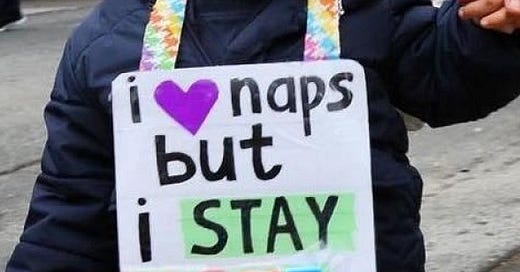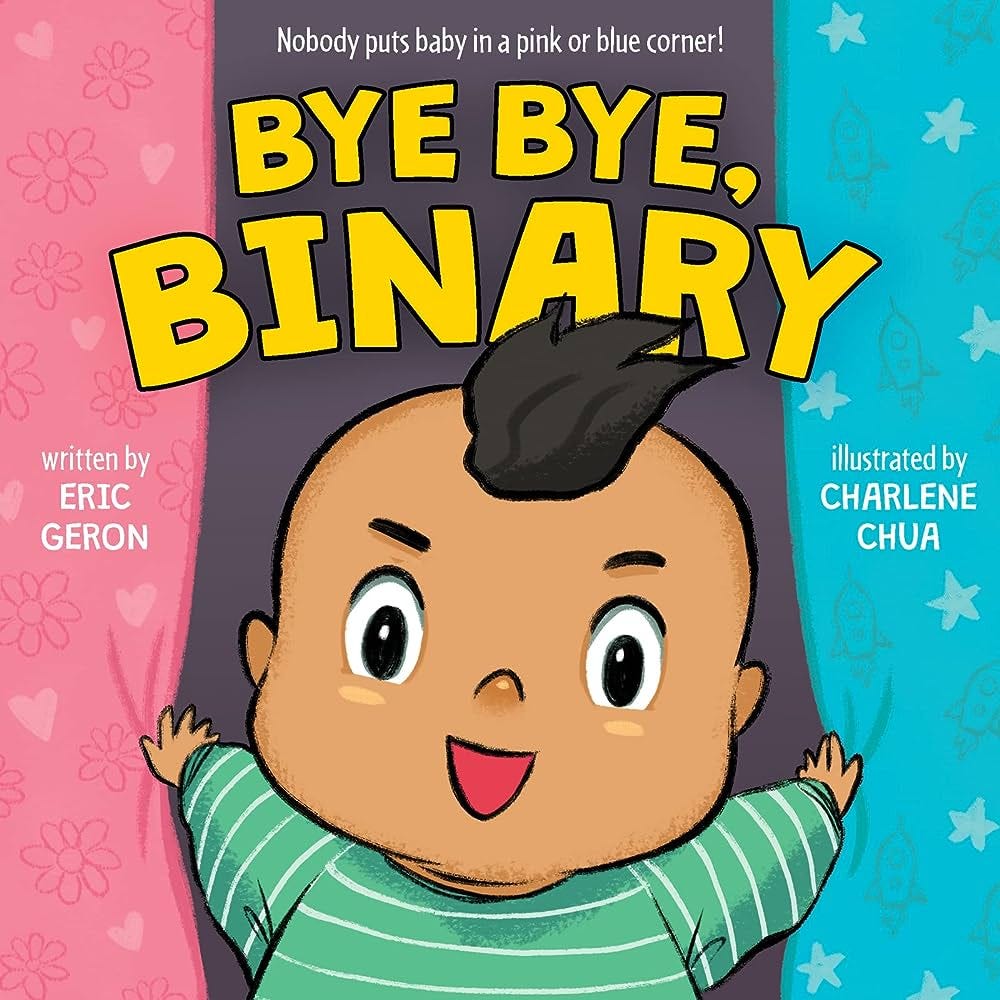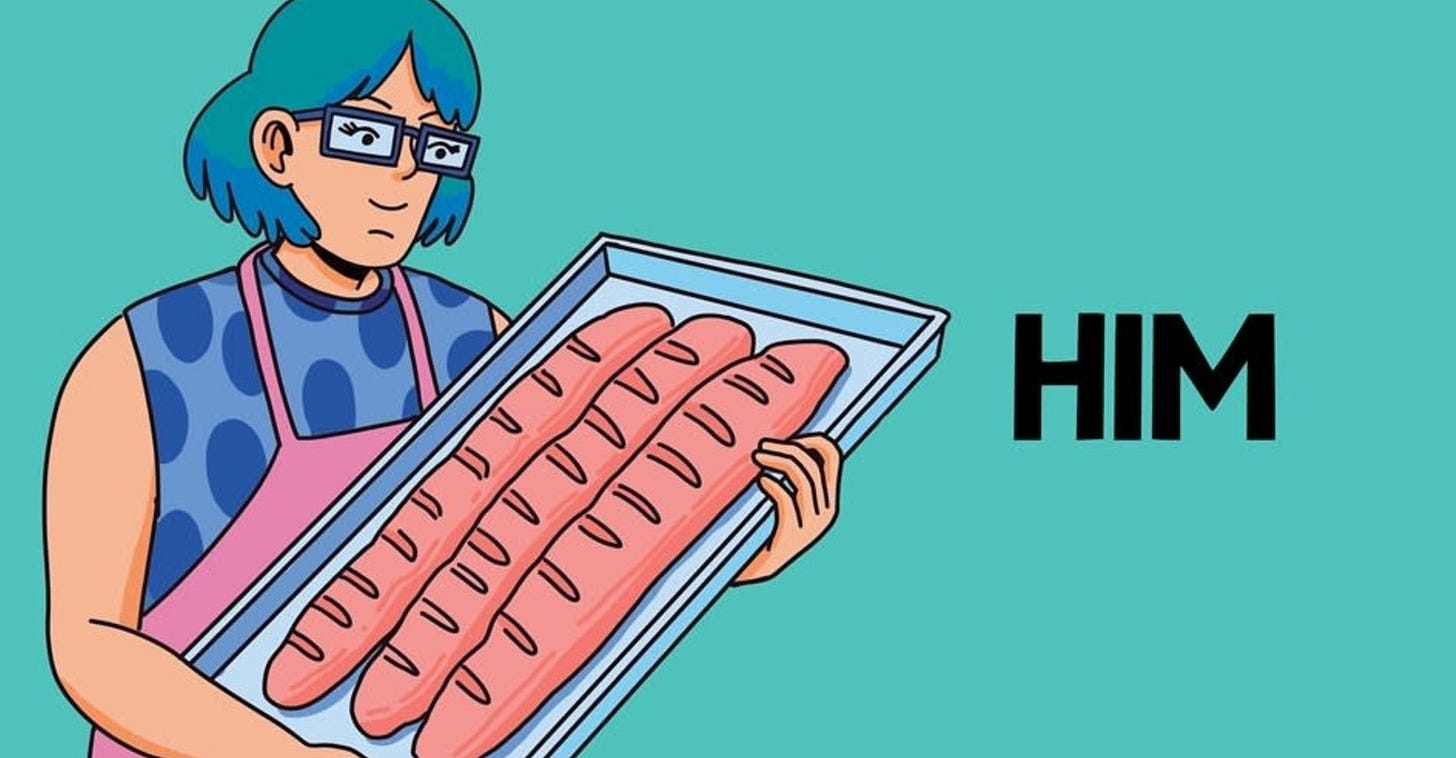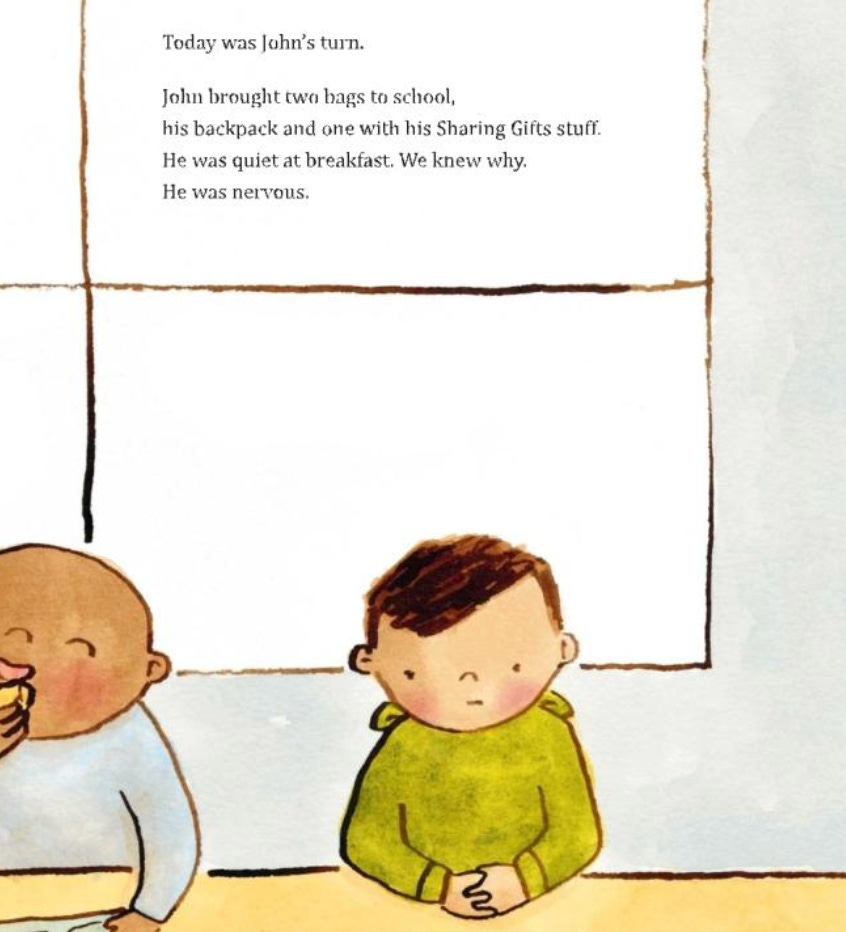The baby on the cover of Bye Bye, Binary by Eric Geron is ugly. Rendered in the flat, soulless style of a WikiHow article or South Park character, the presumably nonbinary toddler bursts forth from between two curtains: pink on one side, blue on the other. The baby is bald — which is fine, a likely thing for a baby to be — save for a sort of pompadour-mohawk hair thing in the center of their head. (Already, the book reinforces the stereotype that we as queer people must resign ourselves to a lifetime of bad haircuts. Sad!) In case one didn’t already pick up on the book’s very subtle message, a logline above our protagonist’s mohawkadour helps explain: “Nobody puts baby in a pink or blue corner.”
Wait. Huh? What was meant to elucidate in fact obfuscates — is this a book about gender for children aged zero to four, or a parody of Dirty Dancing featuring a nonbinary Patrick Swayze?1
Neither option is particularly appealing, but it’s the former. Over the course of 24 cardboard pages, the baby rejects the colors pink and blue in favor of “lots of colors.” They are eager, we learn, to “smash gender norms” because “they’re only social constructs anyways.” It is difficult to imagine a baby resonating with this language, but I applaud any parent who successfully explains the definition of “social construct” to someone who hasn’t yet established object permanence and is probably actively shitting and pissing themselves.
Lest you mistake me for a reactionary, let me clarify: Drop me in a room full of Turning Point USA guys, and I’m defending Bye Bye, Binary to my last breath. I’d do the same if I were writing for a place with sweeping cultural influence like, say, the New York Times. Critiquing any LGBTQ kids’ book feels a bit gauche at a time when Republican lawmakers are obsessed with eradicating queer and trans people from public life. And as if bathrooms, sports fields, and doctors’ offices weren’t enough, school libraries have become the latest hotspot for the right’s culture wars crusade. Last year, the American Library Association “reported the highest number of attempted book bans since it began tracking such attempts in 2001,” with over half of the challenged books featuring queer themes.
Representation is good. And, frankly, if more kids read books that somehow turn them gay, that’s a win-win to me. The problem isn’t that children’s books about queerness exist — it’s that Bye Bye, Binary is but one of many trite, didactic, and uninspired texts.
Ironically, some of the books end up reinforcing gender stereotypes in their attempts to dismantle them. In My Shadow is Purple by Scott Stuart, the child’s father has a shadow that’s “blue as a berry,” while their mother’s shadow is “pink as a blossoming cherry.” While I do appreciate the rhyme scheme, come on — the pink versus blue dichotomy? In 2023? Totally uninspired. The child instead has a purple shadow, which is, you might’ve noticed, the combination of pink and blue. They like to play with “all sorts of toys,” including “things loved by girls and things loved by boys.” Similarly, in Bye Bye, Binary, the baby likes to play with both “dolls AND dinosaurs.”
I’m not really sure what we’re doing here, aside from reifying “nonbinary” as a third, discrete gender, a composite of the two clearly delineated genders of “man” and “woman.” It would be nice if, instead, these books would reject the rigid taxonomical thinking that got us here in the first place. In other words, in a fictional universe of boundless possibility, it's sad that there are still girls’ toys and boys’ toys.
Next, there are the pronoun books: literally, The Pronoun Book, for ages “baby to three”; They, He, She: Words for You and Me, not to be confused with They, She, He, Me: Free to Be! (different authors); and What Are Your Words?, featuring a kid who evidently lives in Bushwick, because they have “lots of neighbors” that use the pronouns “they/them, ey/em, and ze/zir.”
This fixation on pronouns is telling, born from a generation whose understanding of gender expression starts and stops at the email signature or Instagram bio. Where are the books on adverbs, prepositions, and conjunctions? No wonder we’re in a damn literacy crisis. It’s good to teach kids respect, but pronouns, while important, are ultimately a signifier; they say more about what you’re called than who you are. I’m reminded of Brock Colyar’s excellent essay last year in The Cut: “I can’t help but think that the walking-on-eggshells battle for pronouns is turning my gender into a human-resources-approved corporate product.”
Perhaps this is the logical endpoint of pronoun culture: a new horde of insipid, unfussy kids’ books about pronouns, churned out en masse by major publishing houses who would like to look woke, but not too woke, of course.2 This might also be why there are at least three — three!! — picture books on RuPaul, and nothing on Paris Dupree.
It’s not just LGBTQ books, though. A survey of the contemporary picture book landscape in its totality yields bleak results. Bye Bye, Binary is marketed to fans of Feminist Baby by Loryn Brantz, which seems to have inspired, at least in part, Antiracist Baby by Ibram X. Kendi.3
These are all good things for a baby to be. If I ever have kids, I would like to teach them to be feminist and antiracist, rather than the opposite. I will not, however, be doing it using these books, which seem to be written less for babies and more for Rachel Maddow Moms trying to score political points. For example, one piece of Antiracist Baby’s advice is to “point at policies as the problem, not people.” What policy is a seven-month-old even concerned with? Big Naptime?
The truth is, I’m being a hater because there are a handful of worthwhile picture books that put these examples to shame. Kids are smarter than we give them credit for, and they deserve more than vapid buzzwords and lazy platitudes. Antiracist Baby tells kids to “celebrate our differences”; a good picture book shows a young reader what that actually looks like.
Take John’s Turn by Mac Barnett for example. The premise is simple: an elementary school holds weekly assemblies, and at the end of each one, a different kid gets the chance to share something that’s important to them with the rest of the school. This week, it’s John’s turn; he’s prepared a ballet routine. Before he starts, the kids laugh and grumble. Then there’s a spread of wordless pages that depict John dancing in his leotard and ballet flats. At first, he seems nervous, but as we keep turning the pages, he looks increasingly comfortable, until he finally leaps across the centerfold in a blaze of pink and orange watercolor, arms outstretched triumphantly, a soft, blushing smile on his face. He bows, and — spoiler alert — everyone claps. The book doesn’t need to say, “Here is something that has traditionally been gendered as ‘female,’ but John is destroying the gender binary.” John simply is, and when he shows who he is to the world, his classmates love him regardless.
Julián is a Mermaid by Jessica Love, winner of a 2019 Stonewall Book Award, is another favorite of mine. Julián is on the subway with his abuela when he sees a group of women dressed up as mermaids. He tells his abuela that he is also a mermaid, and once they get home, he puts on her makeup, adds flowers to his hair, and ties a curtain around his waist like a skirt. When she walks into the room and sees Julián all dressed up, she just hands him a pearl necklace: “For you, Julián.” Then, she takes him to the beach so that he can join the promenade of mermaids, too. It’s an artful reference to the Coney Island Mermaid Parade that takes place each June, and the book’s illustrations perfectly capture the woozy, heat-drenched feeling of a New York summer. It’s some of the most beautiful artwork I’ve ever seen in a picture book, a whimsical menagerie of watercolor and ink. (Look it up — words really don’t do this one justice.)
Books like John’s Turn and Julián is a Mermaid encourage exploration, creativity, and self-discovery, without sacrificing the medium for the message. They treat kids as whole, multifaceted beings, curious minds deserving of good stories and great art.
So, is Bye Bye, Binary really that bad? Honestly, no, it could be worse. But we as adults should be able to imagine — and demand — better kids’ books. After all, the future quite literally depends on them.
I have never seen Dirty Dancing.
Case in point: Earlier this year, Scholastic created a new, opt-in category for diverse books focused on antiracism, queerness, immigration, and more. This made it easy for school officials “to exclude the entire section from their schools’ book fairs in one fell swoop,” as The Intercept reported in October. (Yeah, I edited the piece.) After receiving widespread backlash, Scholastic reversed course and apologized. Woke but not too woke unless being not too woke looks bad in which case woke again. Now that’s allyship.







Incredible piece :) I'm so excited for more! Also, I too have a bone to pick with Big Naptime.
This made me actually laugh out loud--loved it sm. Gonna send to a few friends <3